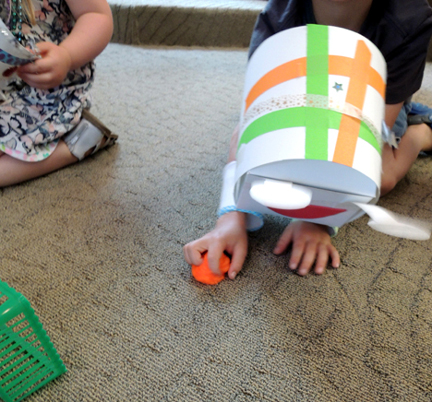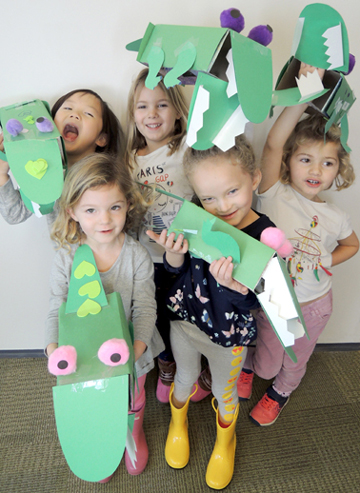
These snap-tastic alligator puppets are adorable…and hungry! But what do you feed a story time alligator? Literally, anything!
We read Suddenly Alligator, written by Rick Walton, and illustrated by Jim Bradshaw (Gibbs Smith, 2004). When a young man’s socks hit the 3 month “no wash” limit, he heads to town to purchase a new pair. Along the way, an alligator gives chase. Nothing in the boy’s pockets seem to thwart this ferocious beast, until the alligator gets a whiff of the boy’s socks. Much to his relief, it knocks the alligator right out! In addition to hilarious illustrations of the ferocious, relentless alligator, the book ends each section with an adverb – anxiously, cautiously, hungrily, boldly, desperately, fondly – making it a fantastically funny read aloud.
You’ll need:
- 1 large large tissue box
- Green construction paper
- Green poster board
- White card stock
- 1 alligator puppet mouth template, printed on 8.5″ x 11″ paper
- 2 jumbo pom-poms
- Scissors, tape, and a stapler for construction
- Markers for decorating
In the book, the alligator devours a pair of pliers the boy throws at him. We thought it would be funny to make a puppet that eats things too. In this case, a plastic ball:
First, cut one end off a tissue box. This is where your alligator’s mouth will attach. Next, cut extra space around the tissue-dispensing slit. This allows the puppeteer’s hand to move more freely, and makes it easier to remove objects the alligator has “eaten.”
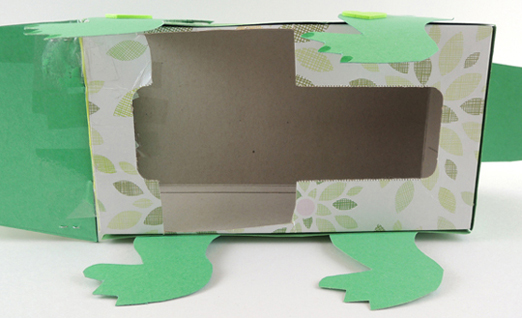 The alligator’s mouth consists of 2 “mouth pockets.” Print the template, and then cut 2 top mouth pockets out of green poster board. Staple the 2 pieces together to form a pocket:
The alligator’s mouth consists of 2 “mouth pockets.” Print the template, and then cut 2 top mouth pockets out of green poster board. Staple the 2 pieces together to form a pocket:
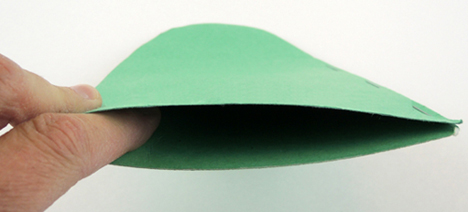 Now tape the mouth pocket to the top of the tissue box. Important! Just tape the TOP piece of the mouth pocket to the box. You’ll need to leave the bottom piece free so you can slip your fingers into the pocket and operate the puppet. Here’s a photo of the taped mouth pocket. I used red masking tape so you can see what I’m describing more clearly:
Now tape the mouth pocket to the top of the tissue box. Important! Just tape the TOP piece of the mouth pocket to the box. You’ll need to leave the bottom piece free so you can slip your fingers into the pocket and operate the puppet. Here’s a photo of the taped mouth pocket. I used red masking tape so you can see what I’m describing more clearly:
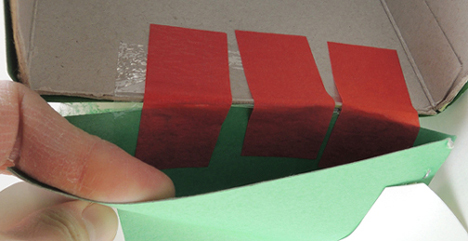 Repeat the above steps with the bottom mouth pocket, then add card stock teeth to the mouth. To operate the puppet, slide your fingers in the top mouth pocket, and your thumb in the lower mouth pocket.
Repeat the above steps with the bottom mouth pocket, then add card stock teeth to the mouth. To operate the puppet, slide your fingers in the top mouth pocket, and your thumb in the lower mouth pocket.
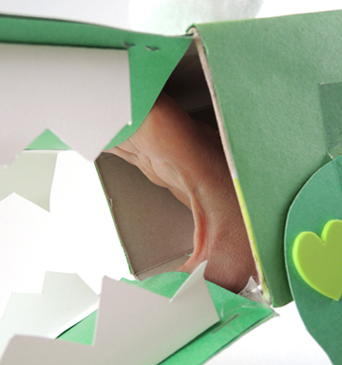 Here’s the finished alligator…we used green construction paper for the body, and green poster board for the legs and tail. Notice that the legs dangle off the bottom of the box with tape hinges – the puppet sits better in your arms that way. The eyes are jumbo pom-poms with dot sticker pupils (paper circles work too). We also offered green self-adhesive foam shapes for additional texture (or just use markers).
Here’s the finished alligator…we used green construction paper for the body, and green poster board for the legs and tail. Notice that the legs dangle off the bottom of the box with tape hinges – the puppet sits better in your arms that way. The eyes are jumbo pom-poms with dot sticker pupils (paper circles work too). We also offered green self-adhesive foam shapes for additional texture (or just use markers).
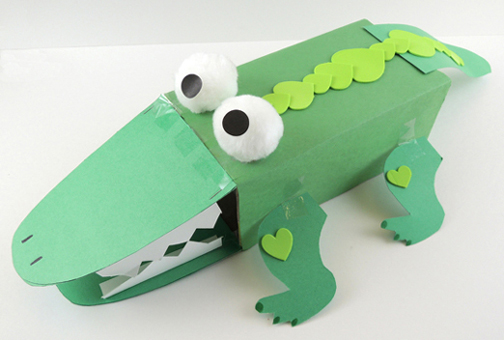 Each kid got to take home a plastic ball for the alligator to consume, but as the kids milled around the gallery, the alligators started eating EVERYTHING. Scarves, pens, socks, hats…if it fit in the box, the gator consumed it!
Each kid got to take home a plastic ball for the alligator to consume, but as the kids milled around the gallery, the alligators started eating EVERYTHING. Scarves, pens, socks, hats…if it fit in the box, the gator consumed it!

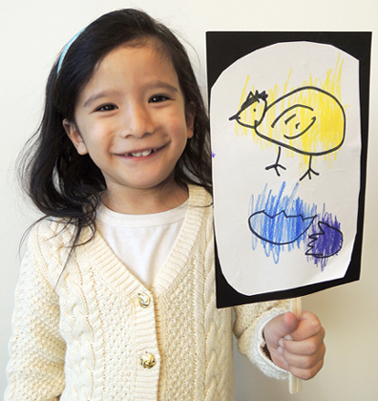 Flip the puppet back and forth to reveal a simple, dynamic story! This project was part of our library’s World Kamishibai Day
Flip the puppet back and forth to reveal a simple, dynamic story! This project was part of our library’s World Kamishibai Day 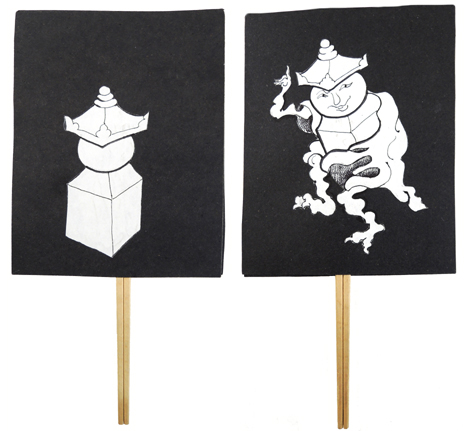 It’s way cooler to see the puppet in action though…
It’s way cooler to see the puppet in action though…
 A very sweet butterfly…
A very sweet butterfly…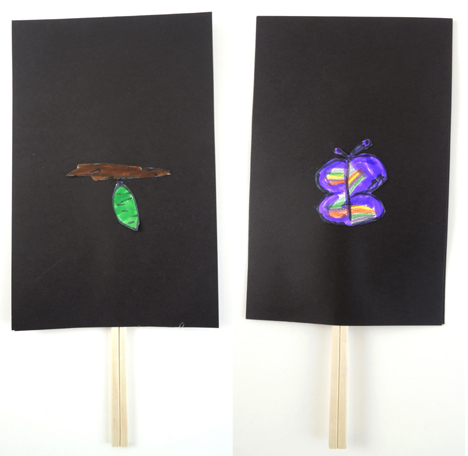 A single fish that goes “Pop!” and turns into a school of fish…
A single fish that goes “Pop!” and turns into a school of fish…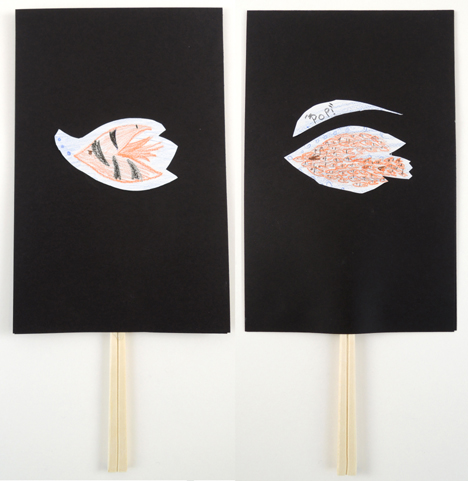 An exploding firework…
An exploding firework…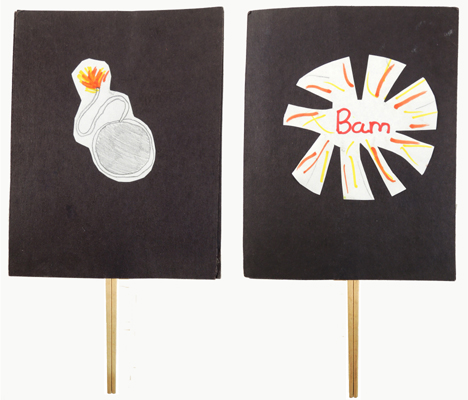 And a girl that duplicates into 5 girls!
And a girl that duplicates into 5 girls! If that last one seems a little confusing, it was inspired by a kamishibai performance of Manmaru manma tantakatan (written by Fumiko Araki, and illustrated by Takuya Kusumi). It’s about a ninja boy who duplicates himself to foil a wicked serpent.
If that last one seems a little confusing, it was inspired by a kamishibai performance of Manmaru manma tantakatan (written by Fumiko Araki, and illustrated by Takuya Kusumi). It’s about a ninja boy who duplicates himself to foil a wicked serpent.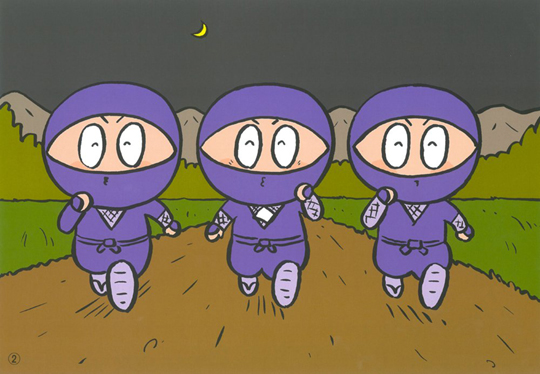
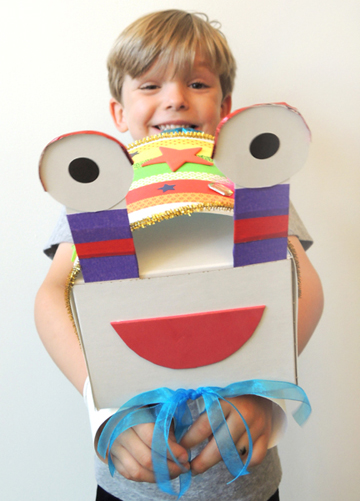
 Assembling this hand puppet is incredibly easy. The eye stalks are made with white poster board (we used
Assembling this hand puppet is incredibly easy. The eye stalks are made with white poster board (we used 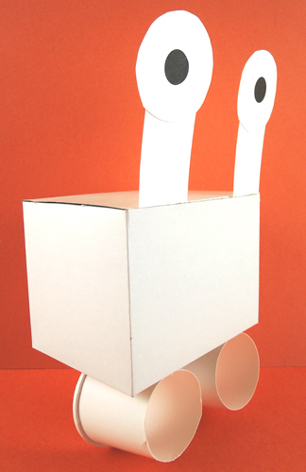 The shell is a 6.75″ x 17″ piece of white poster board arched over the box and secured to the sides of the box with tape or hot glue. The shell sticks out behind the box about 1.5″ to hide the puppeteers arms a little.
The shell is a 6.75″ x 17″ piece of white poster board arched over the box and secured to the sides of the box with tape or hot glue. The shell sticks out behind the box about 1.5″ to hide the puppeteers arms a little.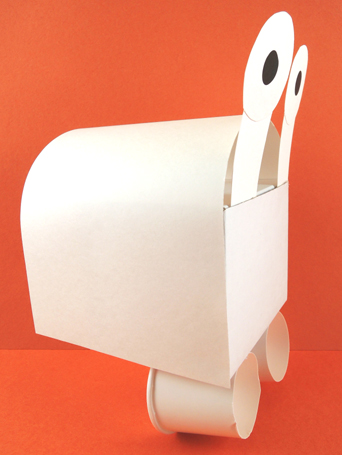 We recommend decorating the shell before you attach it to the box of course. We brought out
We recommend decorating the shell before you attach it to the box of course. We brought out 